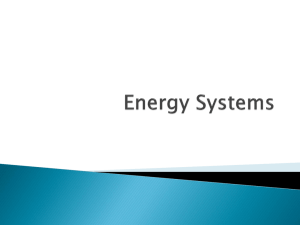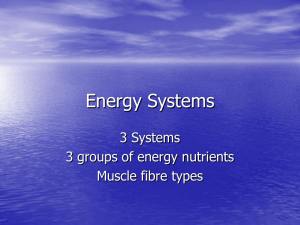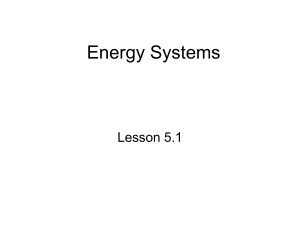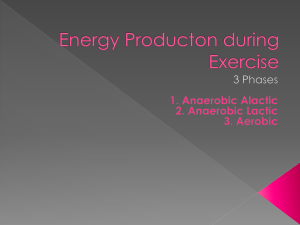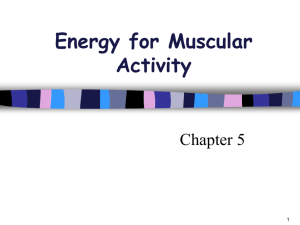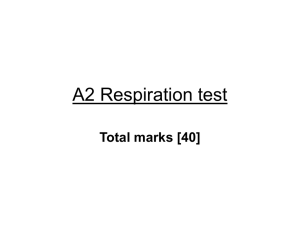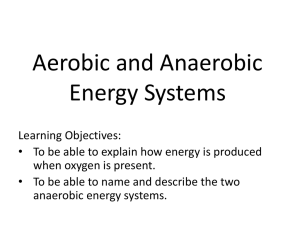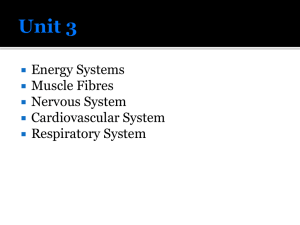Intro powerpoint Energy systems
advertisement
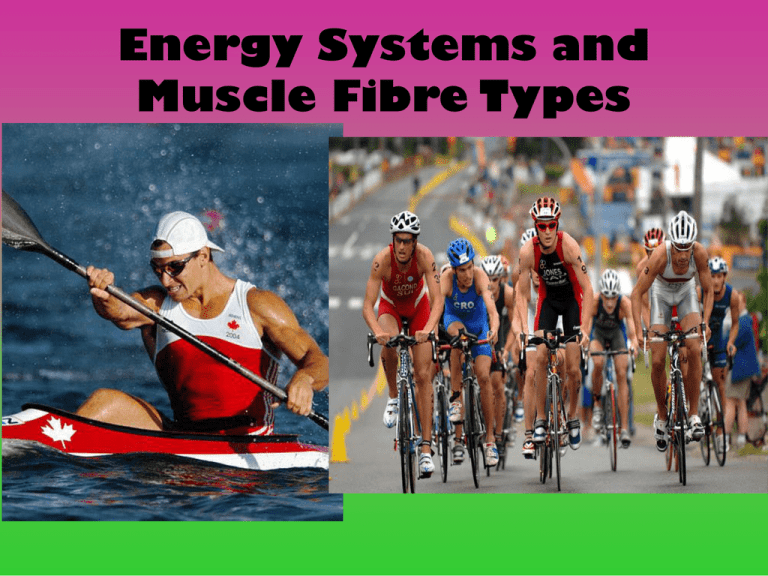
Energy Systems and Muscle Fibre Types Three Key Energy Nutrients The food that we eat is broken down into three nutrients during digestion: Protein Fats Carbohydrates Carbohydrates Yield 4 calories per gram Originate from plants i.e. Fruits and vegetables, and grains i.e. Bread and pasta In the body carbohydrates are broken down in glucose Stored in the liver as glycogen : glucose that is stored in this way can be broken down as needed and carried through the body by blood and used as an energy source ATP – Adenosine Triphosphate Before nutrients can be used as energy they need to be reformed into a universal form of energy that can be used for muscle contraction This form of energy is ATP ATP consists of 3 phosphates attached by high-energy bonds to adenosine Energy is released when phosphate is broken from the ATP molecule ATP --> ADP + P +ENERGY Two Energy Systems - Anaerobic anaerobic (without oxygen): occurs quickly in the muscle fibre uses chemicals and enzymes that are already present Short-lived physical actions Two Energy Systems - Aerobic Occurs in mitochondria Leads to complete breakdown of glucose Fats and proteins are also used Three Metabolic Pathways Anaerobic and aerobic systems overlap Used in all physical activity Within the 2 energy systems there are 3 metabolic pathways ATP-PC (anaerobic alactic) Glycolysis pathway (anaerobic lactic) Cellular respiration (aerobic) ATP-PC (Anaerobic alactic) First and simplest pathway Yields enough ATP for about 10-15 seconds of work PC = phosphocreatine, a compound that is stored in the muscle and readily accessible Can be broken off easily and can be used to convert ADP back to ATP PC + ADP --> ATP + CREATINE Ex: 100 m, high jump, etc. ATP-PC cont... “alactic” since it doesn't create lactic acid as a by-product This system relies solely on readily available phosphocreatine found in the muscles Does NOT involve the metabolism (breakdown) of glucose as an energy source Glycolysis (Anaerobic Lactic) This pathway is the first step to the complete breakdown of glucose The amount of ATP produced by this process will allow an athlete to engage in a high level of performance for an additional 1-3 minutes Glucose is partially broken down to provide ATP More complex than ATP-PC – involves 11 reactions and yields twice as much ATP Does not require oxygen to rapidly produce ATP Glycolysis cont... Through a series of reactions, glycolysis transfers energy from glucose and rejoins phosphate to ADP (creates 2 molecules of ATP) C6H12O6 + 2ADP + 2P --> 2 C3H6O3 + 2ATP + 2 H20 (glucose) (lactate) Glycolysis – Pyruvate and Lactic Acid Pyruvate (pyruvic acid) is the main product of glycolysis Because there is no oxygen this process stops at the glycolysis stage Pyruvic acid is then converted into lactic acid Leads to muscle pain and exhaustion Ex: hockey shift, 400-800m in track, etc. With the presence of oxygen, pyruvate begins the aerobic system Aerobic System Occurs in mitochondria therefore referred to as cellular respiration At this stage fats and proteins can be used as energy sources Fats are the predominant source of energy in exercise lasting longer than 20 min., proteins are used in chronic situation such as starvation Results in the complete breakdown of glucose Aerobic System cont... C6H120 + 6O2 + 36ADP + 36P --> 6CO2 + 36 ATP + 6H2O Yields the highest quantity of ATP (36) Ex: marathon running, triathlon, etc. Cellular respiration involves three separate sub-pathways: Glycolysis Krebs cycle Electron transport chain Sub-pathway: Glycolysis Same as the anaerobic lactic system EXCEPT: In the presence of oxygen, pyruvic acid is converted to acetyl CoA instead of lactic acid Acetyl CoA then enters Krebs cycle Sub-pathway: Krebs Cycle After 8 reactions, 2 ATP molecules are produced Also produced are new compounds capable of storing “high energy” electrons The high energy electrons produced in the Krebs cycle are sent to the mitochondria (electron transport chain) Sub-pathway: Electron Transport Chain Final stage of cellular respiration Large amounts of ATP are produced Carbon dioxide and water are the only byproducts In your notes: - Copy the chart from page 86 into your notes - Refer to the figures 5.5 and 5.6 for a better understanding of the types of energy different sports require

